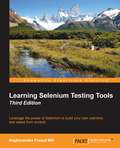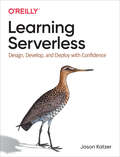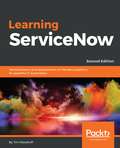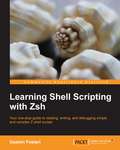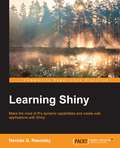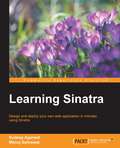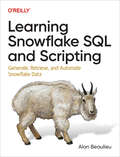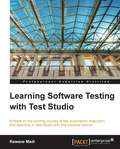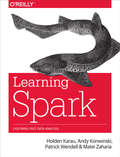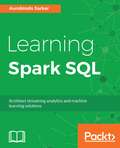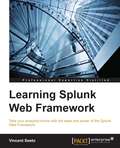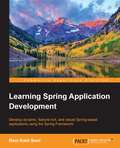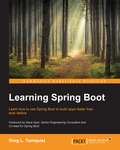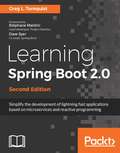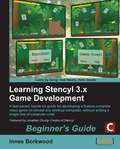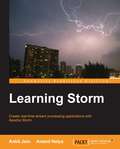- Table View
- List View
Learning Selenium Testing Tools - Third Edition
by Raghavendra Prasad MgIf you are a software developer with a basic knowledge of testing and are interested in automated testing using Selenium, this is the book for you. No prior knowledge of Selenium is required.
Learning Selenium Testing Tools with Python
by Unmesh GundechaIf you are a quality testing professional, or a software or web application developer looking to create automation test scripts for your web applications, with an interest in Python, then this is the perfect guide for you. Python developers who need to do Selenium testing need not learn Java, as they can directly use Selenium for testing with this book.
Learning Serverless: Design, Develop, And Deploy With Confidence
by Jason KatzerWhether your company is considering serverless computing or has already made the decision to adopt this model, this practical book is for you. Author Jason Katzer shows early and mid-career developers what's required to build and ship maintainable and scalable services using this model.With this book, you'll learn how to build a modern production system in the cloud, viewed through the lens of serverless computing. You'll discover how serverless can free you from the tedious task of setting up and maintaining systems in production. You'll also explore new ways to level up your careerand design, develop, and deploy with confidence.In three parts, this book includes:The Path to Production: Examine the ins and outs of distributed systems, microservices, interfaces, and serverless architecture and patternsThe Tools: Dive into monitoring, observability and alerting, logging, pipelines, automation, and deploymentConcepts: Learn how to design security and privacy, how to manage quality through testing and staging, and how to plan for failure
Learning ServiceNow
by Tim WoodruffIT Service management at your fingertips About This Book • Leverage ServiceNow's capabilities to achieve improved service management and excellent results in your IT operations by following step-by-step, practical instructions • Build core administration, management, and maintenance skills with IT service management and IT operations management • Improve your workflow efficiency by designing and creating responsive and automated workflows Who This Book Is For This book is for IT professionals and administrators who are planning to or are already trying to implement ServiceNow in their organization for Enterprise IT service management tasks. Some familiarity with web technologies (JavaScript) would be helpful. System administration experience is necessary. What You Will Learn • Acquire and configure your own free personal developer instance of ServiceNow • Read (and write!) clear, effective requirements for ServiceNow development • Avoid common pitfalls and missteps that could seriously impact future progress and upgradeability • Know how to troubleshoot when things go wrong using debugging tools • Discover developer “tips and tricks” • Pick up great tips from top ServiceNow development and administration professionals, and find out what they wish they knew when they were starting out In Detail This book shows you how to put important ServiceNow features to work in the real world. We will introduce key concepts and examples on managing and automating IT services, and help you build a solid foundation towards this new approach. We'll demonstrate how to effectively implement various system configurations within ServiceNow. We'll show you how to configure and administer your instance, and then move on to building strong user interfaces and creating powerful workflows. We also cover other key elements of ServiceNow, such as alerts and notifications, security, reporting, and custom development. You will learn how to improve your business' workflow, processes, and operational efficiency. By the end of this book, you will be able to successfully configure and manage ServiceNow within your organization. Style and approach This book is a step-by-step practical tutorial to help you quickly deploy and configure ServiceNow in your organization.
Learning ServiceNow: Administration and development on the Now platform, for powerful IT automation, 2nd Edition
by Tim WoodruffIT service management automation at your fingertipsKey FeaturesLearn to leverage ServiceNow’s capabilities for improved IT automation by following step-by-step, practical instructionsBuild core administration, development, and maintenance skills with IT service management in ServiceNowImprove your workflow efficiency by designing and creating responsive and automated workflows, business logic, and front-end automationBook DescriptionThis book is an updated version of Learning ServiceNow, that will cover the new and updated features of the ServiceNow platform. It will show you how to put important ServiceNow features to work in the real world, while introducing key concepts via examples of managing and automating IT services. It'll help you build a solid foundation of knowledge, and will demonstrate how to effectively implement and configure modules within ServiceNow. We'll show you how to configure and administer your instance, and then move on to building strong user interfaces and creating powerful workflows.We also cover other key elements of ServiceNow, such as notifications, security, reporting, and custom development. You will learn how to improve and automate your business' workflow and processes. By the end of this book, you will be able to successfully configure and manage ServiceNow like a pro.What you will learnRead and write clear, effective code for the ServiceNow platformIdentify and avoid common pitfalls and missteps that could seriously impact future progress and upgradeability Use debugging tools to troubleshoot when things go wrongDiscover tips and tricks from top ServiceNow developers, architects, and administrators. Find out what the pros wish they knew when they were starting outWho this book is forThis book is for IT professionals and administrators who are planning to or are already trying to implement ServiceNow in their organization for Enterprise IT service management tasks.Some familiarity with web technologies (JavaScript) would be helpful. Prior ServiceNow experience is not necessary.
Learning Shell Scripting with Zsh
by Gastón FestariA step-by-step tutorial that will teach you, through real-world examples, how to configure and use zsh and its various features. If you are a system administrator, developer, or computer professional involved with UNIX who are looking to improve on their daily tasks involving the UNIX shell, "Learning Shell Scripting with zsh" will be great for you. It's assumed that you have some familiarity with an UNIX command-line interface and feel comfortable with editors such as Emacs or vi.
Learning ShiVa3D Game Development
by Wade TracyThis book is a step-by-step, hands-on introduction to the basics of mobile game development with the ShiVa3D game engine. This book assumes no prior mobile game development or ShiVa3D experience, and is therefore suited to the absolute beginner looking to learn about both. Although previous programming experience will be beneficial, it is not necessary. Because game development platforms are so diverse, this book will also serve as a quick introduction for seasoned game developers that are looking to take advantage of the power of ShiVa3D. In either case the book also introduces the reader to resources for further learning.
Learning Shiny
by Hernan G ResnizkyIf you are a data scientist who needs a platform to show your results to a broader audience in an attractive and visual way, or a web developer with no prior experience in R or Shiny, this is the book for you.
Learning Sinatra
by Manoj Sehrawat Sudeep AgarwalDesign and deploy your own web application in minutes using Sinatra About This Book * Exploit Sinatra to design a web application * Integrate external, internal, and inline CSS and use some popular CSS frameworks * Deploy an application onto your own server or on a cloud application platform Who This Book Is For Learning Sinatra is a great place to start your first Sinatra application. It doesn't matter whether you have written a web application before or not, though some basic knowledge of programming is essential. What You Will Learn * Install and set up Ruby and Sinatra * Work with layouts and template routes * Extend the code to include CSS in different ways * Create projects and understand MVC * Design the front-end with Twitter Bootstrap * Use the MySQL/SQLite gem to communicate with databases * Implement sessions that can be used across multiple pages * Utilize the innovative and user-friendly features of ORMs In Detail Sinatra is a Ruby framework that is widely used in the Industry. You can use it to make a single-page web app or a large-scale one. With the increased online footprint, you can create and deploy your own application. Whether you are brand-new to online learning or a seasoned expert, this book will provide you with the skills you need to successfully create, customize, and deploy a Sinatra application. Starting from the beginning, this book will cover how to install Ruby and Sinatra, construct the back-end, design and customize the front-end layout, and utilize the innovative and user-friendly features of ORMs. By sequentially working through the steps in each chapter, you will quickly master Sinatra's features to create your own application. With ample screenshots and code that offers a play-by-play account of how to build an application, Learning Sinatra will ensure your success with this cutting-edge framework. Style and approach This book takes a step-by-step approach to Sinatra and explains it in a conversational and easy-to-follow style. A simple project is used as a base to explain each topic. The code and screenshots included add to the ease of learning.
Learning Single-page Web Application Development
by Fernando MonteiroThis book is aimed at web developers who are familiar with frontend technologies like JavaScript, HTML, and CSS, and modern tools like Bower, Yeoman, and Grunt.
Learning Snowflake SQL and Scripting: Generate, Retrieve, and Automate Snowflake Data
by Alan BeaulieuTo help you on the path to becoming a Snowflake pro, this concise yet comprehensive guide reviews fundamentals and best practices for Snowflake's SQL and Scripting languages. Developers and data professionals will learn how to generate, modify, and query data in the Snowflake relational database management system as well as how to apply analytic functions for reporting.Author Alan Beaulieu also shows you how to create scripts, stored functions, and stored procedures to return data sets using Snowflake Scripting. This book is ideal whether you're new to databases and need to run queries or reports against a Snowflake database, or transitioning from databases such as Oracle, SQL Server, or MySQL to cloud-based platforms.With this book, you will:Generate and modify Snowflake data using INSERT, UPDATE, DELETEQuery data in Snowflake using SELECT, including joining multiple tables, using subqueries, and groupingApply analytic functions for performing subtotals, grand totals, row comparisons, and other reporting functionalityBuild scripts combining SQL statements with looping, if-then-else, and exception handlingLearn how to build stored procedures and functionsUse stored procedures to return data sets
Learning Social Media Analytics with R
by Raghav Bali Dipanjan Sarkar Tushar SharmaTap into the realm of social media and unleash the power of analytics for data-driven insights using R About This Book • A practical guide written to help leverage the power of the R eco-system to extract, process, analyze, visualize and model social media data • Learn about data access, retrieval, cleaning, and curation methods for data originating from various social media platforms. • Visualize and analyze data from social media platforms to understand and model complex relationships using various concepts and techniques such as Sentiment Analysis, Topic Modeling, Text Summarization, Recommendation Systems, Social Network Analysis, Classification, and Clustering. Who This Book Is For It is targeted at IT professionals, Data Scientists, Analysts, Developers, Machine Learning Enthusiasts, social media marketers and anyone with a keen interest in data, analytics, and generating insights from social data. Some background experience in R would be helpful, but not necessary, since this book is written keeping in mind, that readers can have varying levels of expertise. What You Will Learn • Learn how to tap into data from diverse social media platforms using the R ecosystem • Use social media data to formulate and solve real-world problems • Analyze user social networks and communities using concepts from graph theory and network analysis • Learn to detect opinion and sentiment, extract themes, topics, and trends from unstructured noisy text data from diverse social media channels • Understand the art of representing actionable insights with effective visualizations • Analyze data from major social media channels such as Twitter, Facebook, Flickr, Foursquare, Github, StackExchange, and so on • Learn to leverage popular R packages such as ggplot2, topicmodels, caret, e1071, tm, wordcloud, twittR, Rfacebook, dplyr, reshape2, and many more In Detail The Internet has truly become humongous, especially with the rise of various forms of social media in the last decade, which give users a platform to express themselves and also communicate and collaborate with each other. This book will help the reader to understand the current social media landscape and to learn how analytics can be leveraged to derive insights from it. This data can be analyzed to gain valuable insights into the behavior and engagement of users, organizations, businesses, and brands. It will help readers frame business problems and solve them using social data. The book will also cover several practical real-world use cases on social media using R and its advanced packages to utilize data science methodologies such as sentiment analysis, topic modeling, text summarization, recommendation systems, social network analysis, classification, and clustering. This will enable readers to learn different hands-on approaches to obtain data from diverse social media sources such as Twitter and Facebook. It will also show readers how to establish detailed workflows to process, visualize, and analyze data to transform social data into actionable insights. Style and approach This book follows a step-by-step approach with detailed strategies for understanding, extracting, analyzing, visualizing, and modeling data from several major social network platforms such as Facebook, Twitter, Foursquare, Flickr, Github, and StackExchange. The chapters cover several real-world use cases and leverage data science, machine learning, network analysis, and graph theory concepts along with the R ecosystem, including popular packages such as ggplot2, caret,dplyr, topicmodels, tm, and so on.
Learning Software Testing with Test Studio
by Rawane MadiLearning Software Testing with Test Studio is a practical, hands-on guide that will help you get started with Test Studio to design your automated solution and tests. All through the book, there are best practices and tips and tricks inside Test Studio which can be employed to improve your solution just like an experienced QA.If you are a beginner or a professional QA who is seeking a fast, clear, and direct to the point start in automated software testing inside Test Studio, this book is for you. You should be familiar with the .NET framework, mainly Visual Studio, C#, and SQL, as the book's examples rely on them. Prior testing knowledge will also be helpful.
Learning Spark
by Holden Karau Patrick Wendell Andy Konwinski Matei ZahariaData in all domains is getting bigger. How can you work with it efficiently? This book introduces Apache Spark, the open source cluster computing system that makes data analytics fast to write and fast to run. With Spark, you can tackle big datasets quickly through simple APIs in Python, Java, and Scala.Written by the developers of Spark, this book will have data scientists and engineers up and running in no time. You'll learn how to express parallel jobs with just a few lines of code, and cover applications from simple batch jobs to stream processing and machine learning.Quickly dive into Spark capabilities such as distributed datasets, in-memory caching, and the interactive shellLeverage Spark's powerful built-in libraries, including Spark SQL, Spark Streaming, and MLlibUse one programming paradigm instead of mixing and matching tools like Hive, Hadoop, Mahout, and StormLearn how to deploy interactive, batch, and streaming applicationsConnect to data sources including HDFS, Hive, JSON, and S3Master advanced topics like data partitioning and shared variables
Learning Spark SQL
by Aurobindo SarkarDesign, implement, and deliver successful streaming applications, machine learning pipelines and graph applications using Spark SQL API About This Book • Learn about the design and implementation of streaming applications, machine learning pipelines, deep learning, and large-scale graph processing applications using Spark SQL APIs and Scala. • Learn data exploration, data munging, and how to process structured and semi-structured data using real-world datasets and gain hands-on exposure to the issues and challenges of working with noisy and "dirty" real-world data. • Understand design considerations for scalability and performance in web-scale Spark application architectures. Who This Book Is For If you are a developer, engineer, or an architect and want to learn how to use Apache Spark in a web-scale project, then this is the book for you. It is assumed that you have prior knowledge of SQL querying. A basic programming knowledge with Scala, Java, R, or Python is all you need to get started with this book. What You Will Learn • Familiarize yourself with Spark SQL programming, including working with DataFrame/Dataset API and SQL • Perform a series of hands-on exercises with different types of data sources, including CSV, JSON, Avro, MySQL, and MongoDB • Perform data quality checks, data visualization, and basic statistical analysis tasks • Perform data munging tasks on publically available datasets • Learn how to use Spark SQL and Apache Kafka to build streaming applications • Learn key performance-tuning tips and tricks in Spark SQL applications • Learn key architectural components and patterns in large-scale Spark SQL applications In Detail In the past year, Apache Spark has been increasingly adopted for the development of distributed applications. Spark SQL APIs provide an optimized interface that helps developers build such applications quickly and easily. However, designing web-scale production applications using Spark SQL APIs can be a complex task. Hence, understanding the design and implementation best practices before you start your project will help you avoid these problems. This book gives an insight into the engineering practices used to design and build real-world, Spark-based applications. The book's hands-on examples will give you the required confidence to work on any future projects you encounter in Spark SQL. It starts by familiarizing you with data exploration and data munging tasks using Spark SQL and Scala. Extensive code examples will help you understand the methods used to implement typical use-cases for various types of applications. You will get a walkthrough of the key concepts and terms that are common to streaming, machine learning, and graph applications. You will also learn key performance-tuning details including Cost Based Optimization (Spark 2.2) in Spark SQL applications. Finally, you will move on to learning how such systems are architected and deployed for a successful delivery of your project. Style and approach This book is a hands-on guide to designing, building, and deploying Spark SQL-centric production applications at scale.
Learning Spark: Lightning-Fast Data Analytics
by Denny Lee Jules S. Damji Brooke Wenig Tathagata DasData is bigger, arrives faster, and comes in a variety of formatsâ??and it all needs to be processed at scale for analytics or machine learning. But how can you process such varied workloads efficiently? Enter Apache Spark.Updated to include Spark 3.0, this second edition shows data engineers and data scientists why structure and unification in Spark matters. Specifically, this book explains how to perform simple and complex data analytics and employ machine learning algorithms. Through step-by-step walk-throughs, code snippets, and notebooks, youâ??ll be able to:Learn Python, SQL, Scala, or Java high-level Structured APIsUnderstand Spark operations and SQL EngineInspect, tune, and debug Spark operations with Spark configurations and Spark UIConnect to data sources: JSON, Parquet, CSV, Avro, ORC, Hive, S3, or KafkaPerform analytics on batch and streaming data using Structured StreamingBuild reliable data pipelines with open source Delta Lake and SparkDevelop machine learning pipelines with MLlib and productionize models using MLflow
Learning Splunk Web Framework
by Vincent SestoTake your analytics online with the ease and power of the Splunk Web Framework About This Book * Want to build rich applications on the Web using Splunk? This book will be your ultimate guide! * Learn to use web framework components with the help of this highly practical, example-rich guide * Perform excellent Splunk analytics on the Web and bring that knowledge to your own projects Who This Book Is For This book will cater to Splunk developers and administrators who now wish to further their knowledge with Splunk Web Framework and learn to improve the way they present and visualize data in Splunk. A basic knowledge of JavaScript will be beneficial but is not a prerequisite. What You Will Learn * Master the fundamentals of Splunk Web Framework * Start thinking of Splunk as a complete development platform to build user-friendly apps * Extend the functionality of your apps using SimpleXML techniques * Set up dashboard layouts, navigation, and menus in your apps * Create simple dashboard elements including charts and tables * Master the art of interacting with searches and dashboards * Integrate SplunkJS to add visual appeal to your website In Detail Building rich applications on the Web using Splunk is now simpler than ever before with the Splunk Web Framework. It empowers developers to build their own web applications with custom dashboards, tables, charts, form searches, and other functionalities in the datasets at their disposal. The book will start with the fundamentals of the Splunk Web Framework, teaching you the secrets of building interesting and user-friendly applications. In the first application, you will learn to analyze and monitor traffic hitting the NASA website and learn to create dashboards for it. You will then learn additional, and more detailed, techniques to enhance the functionalities of the app such as dashboards and forms, editing simple XML, using simple XML extensions, tokens, post-process searches, dynamic drill-downs, the Splunk Web Framework and REST API, and much more. The second app will use historical stock market data and will create custom dashboards using Splunk Web Framework; the book will now cover important topics such as creating HTML dashboards, enhancing the visual appeal of the app using CSS, and moving your app with SplunkJS. The book will provide different and interesting examples instead of the usual "Log, Index, Search, and Graph" so that Splunk will be the first tool readers think of to resolve a problem. Style and approach This book will follow a step-by-step approach whereby every new concept is built on top of the previous chapter, and will be highly practical in nature; the reader will learn to build apps while reading about the Splunk Web framework.
Learning Spring 5.0
by Tejaswini Mandar JogBuild, test, and secure robust enterprise-grade applications using the Spring Framework About This Book • Build an enterprise application throughout the book that communicates with a microservice • Define and inject dependencies into your objects using the IoC container • Make use of Spring's reactive features including tools and implement a reactive Spring MVC application Who This Book Is For This book is for Java developers who want to make use of the Spring framework to simplify their programming needs. What You Will Learn • Get to know the basics of Spring development and gain fundamental knowledge about why and where to use Spring Framework • Explore the power of Beans using Dependency Injection, wiring, and Spring Expression Language • Implement and integrate a persistent layer in your application and also integrate an ORM such as Hibernate • Understand how to manage cross-cutting with logging mechanism, transaction management, and more using Aspect-oriented programming • Explore Spring MVC and know how to handle requesting data and presenting the response back to the user • Get to grips with the integration of RESTful APIs and Messaging with WebSocket and STOMP • Master Reactive Programming using Spring MVC to handle non-blocking streams In Detail Spring is the most widely used framework for Java programming and with its latest update to 5.0, the framework is undergoing massive changes. Built to work with both Java 8 and Java 9, Spring 5.0 promises to simplify the way developers write code, while still being able to create robust, enterprise applications. If you want to learn how to get around the Spring framework and use it to build your own amazing applications, then this book is for you. Beginning with an introduction to Spring and setting up the environment, the book will teach you in detail about the Bean life cycle and help you discover the power of wiring for dependency injection. Gradually, you will learn the core elements of Aspect-Oriented Programming and how to work with Spring MVC and then understand how to link to the database and persist data configuring ORM, using Hibernate. You will then learn how to secure and test your applications using the Spring-test and Spring-Security modules. At the end, you will enhance your development skills by getting to grips with the integration of RESTful APIs, building microservices, and doing reactive programming using Spring, as well as messaging with WebSocket and STOMP. Style and approach Filled with examples, this tutorial-based book will help you gain all the knowledge you need to start producing enterprise-grade applications with Spring.
Learning Spring Application Development
by Ravi Kant SoniThis book is intended for those who are interested in learning the core features of the Spring Framework. Prior knowledge of Java programming and web development concepts with basic XML knowledge is expected.
Learning Spring Boot
by Greg L. TurnquistThis book is for both novice developers in general and experienced Spring developers. It will teach you how to override Spring Boot's opinions and frees you from the need to define complicated configurations.
Learning Spring Boot 2.0 - Second Edition: Simplify the development of lightning fast applications based on microservices and reactive programming
by Greg L. TurnquistUse Spring Boot to build lightning-fast apps About This Book • Get up to date with the defining characteristics of Spring Boot 2.0 in Spring Framework 5 • Learn to perform Reactive programming with SpringBoot • Learn about developer tools, AMQP messaging, WebSockets, security, MongoDB data access, REST, and more Who This Book Is For This book is designed for both novices and experienced Spring developers. It will teach you how to override Spring Boot's opinions and frees you from the need to define complicated configurations. What You Will Learn • Create powerful, production-grade applications and services with minimal fuss • Support multiple environments with one artifact, and add production-grade support with features • Find out how to tweak your apps through different properties • Use custom metrics to track the number of messages published and consumed • Enhance the security model of your apps • Make use of reactive programming in Spring Boot • Build anything from lightweight unit tests to fully running embedded web container integration tests In Detail Spring Boot provides a variety of features that address today's business needs along with today's scalable requirements. In this book, you will learn how to leverage powerful databases and Spring Boot's state-of-the-art WebFlux framework. This practical guide will help you get up and running with all the latest features of Spring Boot, especially the new Reactor-based toolkit. The book starts off by helping you build a simple app, then shows you how to bundle and deploy it to the cloud. From here, we take you through reactive programming, showing you how to interact with controllers and templates and handle data access. Once you're done, you can start writing unit tests, slice tests, embedded container tests, and even autoconfiguration tests. We go into detail about developer tools, AMQP messaging, WebSockets, security, and deployment. You will learn how to secure your application using both routes and method-based rules. By the end of the book, you'll have built a social media platform from which to apply the lessons you have learned to any problem. If you want a good understanding of building scalable applications using the core functionality of Spring Boot, this is the book for you. Style and approach This book takes a tutorial-based approach to teach you all you need to know to get up and running with the latest version of Spring Boot. Filled with examples, you will gain hands-on experience of every area that Spring tackles.
Learning Spring Boot 3.0: Simplify the development of production-grade applications using Java and Spring, 3rd Edition
by Josh Long Greg L. Turnquist Mark Heckler Dave SyerBuild Java web apps without wasting any time with this third edition of the best-selling Spring Boot guide for beginners, updated and enhanced with defining features of Spring Boot 3Purchase of the print or Kindle book includes a free eBook PDFKey FeaturesLearn Spring Boot in a cohesive manner with this practical guide by a core Spring contributorDiscover popular Java developer tools such as GraalVM native images, serving up JSON, and moreBuild secure, scalable, and manageable web applications from zero to productionBook DescriptionSpring Boot 3 brings more than just the powerful ability to build secure web apps on top of a rock-solid database. It delivers new options for testing, deployment, Docker support, and native images for GraalVM, along with ways to squeeze out more efficient usage of existing resources.This third edition of the bestseller starts off by helping you build a simple app, and then shows you how to secure, test, bundle, and deploy it to production. Next, you'll familiarize yourself with the ability to go “native” and release using GraalVM. As you advance, you'll explore reactive programming and get a taste of scalable web controllers and data operations. The book goes into detail about GraalVM native images and deployment, teaching you how to secure your application using both routes and method-based rules and enabling you to apply the lessons you've learned to any problem. If you want to gain a thorough understanding of building robust applications using the core functionality of Spring Boot, then this is the book for you.By the end of this Spring Boot book, you'll be able to build an entire suite of web applications using Spring Boot and deploy them to any platform you need.What you will learnCreate powerful, production-grade web applications with minimal fussSupport multiple environments with one artifact, and add production-grade support with featuresFind out how to tweak your Java apps through different propertiesEnhance the security model of your appsMake use of enhancing features such as native deployment and reactive programming in Spring BootBuild anything from lightweight unit tests to fully running embedded web container integration testsGet a glimpse of reactive programming and decide if it's the right approach for youWho this book is forThis book is for both novices and experienced Spring developers looking to learn how to build applications without wasting time on infrastructure and other tedious details. Working knowledge of the Java programming language is assumed.
Learning Stencyl 3.x Game Development: Beginner's Guide
by Innes BorkwoodA step-by-step, practical tutorial with a no-nonsense approach. The book starts by showing readers how to create a playable game that is fully-functioning, then moves on to demonstrate how to fine-tune the game with eye-catching graphics techniques, audio-effects and more.This book is for indie and existing game developers and those who want to get started with game development using Stencyl. Some understanding of Objective-C, C++, and game development basics is recommended. People with some programming experience may also find this book useful.
Learning Storm
by Ankit Jain Anand NalyaIf you are a Java developer who wants to enter into the world of real-time stream processing applications using Apache Storm, then this book is for you. No previous experience in Storm is required as this book starts from the basics. After finishing this book, you will be able to develop not-so-complex Storm applications.
Learning Swift
by Andrew J WagnerIf you are looking to build iOS or OS X apps using the most modern technology, this book is ideal for you. You will find this book especially useful if you are new to programming or if you have yet to develop for iOS or OS X.
